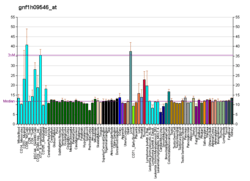Cyclin-dependent kinase 3
Cell division protein kinase 3 is an enzyme that in humans is encoded by the CDK3 gene.[3][4]
Function
CDK3 complements cdc28 mutants of Saccharomyces cerevisiae suggesting that it may be involved in cell cycle control. CDK3 can phosphorylate histone H1 and interacts with an unknown type of cyclin.[4]
References
- 1 2 3 GRCh38: Ensembl release 89: ENSG00000250506 - Ensembl, May 2017
- ↑ "Human PubMed Reference:".
- ↑ Meyerson M, Enders GH, Wu CL, Su LK, Gorka C, Nelson C, Harlow E, Tsai LH (Aug 1992). "A family of human cdc2-related protein kinases". EMBO J. 11 (8): 2909–17. PMC 556772. PMID 1639063.
- 1 2 "Entrez Gene: CDK3 cyclin-dependent kinase 3".
Further reading
- Bullrich F, MacLachlan TK, Sang N, et al. (1995). "Chromosomal mapping of members of the cdc2 family of protein kinases, cdk3, cdk6, PISSLRE, and PITALRE, and a cdk inhibitor, p27Kip1, to regions involved in human cancer". Cancer Res. 55 (6): 1199–205. PMID 7882308.
- Gyuris J, Golemis E, Chertkov H, Brent R (1993). "Cdi1, a human G1 and S phase protein phosphatase that associates with Cdk2". Cell. 75 (4): 791–803. doi:10.1016/0092-8674(93)90498-F. PMID 8242750.
- Sasaguri T, Ishida A, Kosaka C, et al. (1996). "Phorbol ester inhibits the phosphorylation of the retinoblastoma protein without suppressing cyclin D-associated kinase in vascular smooth muscle cells". J. Biol. Chem. 271 (14): 8345–51. doi:10.1074/jbc.271.14.8345. PMID 8626531.
- Meikrantz W, Schlegel R (1996). "Suppression of apoptosis by dominant negative mutants of cyclin-dependent protein kinases". J. Biol. Chem. 271 (17): 10205–9. doi:10.1074/jbc.271.17.10205. PMID 8626584.
- Hofmann F, Livingston DM (1996). "Differential effects of cdk2 and cdk3 on the control of pRb and E2F function during G1 exit". Genes Dev. 10 (7): 851–61. doi:10.1101/gad.10.7.851. PMID 8846921.
- Lamphere L, Fiore F, Xu X, et al. (1997). "Interaction between Cdc37 and Cdk4 in human cells". Oncogene. 14 (16): 1999–2004. doi:10.1038/sj.onc.1201036. PMID 9150368.
- Braun K, Hölzl G, Soucek T, et al. (1998). "Investigation of the cell cycle regulation of cdk3-associated kinase activity and the role of cdk3 in proliferation and transformation". Oncogene. 17 (17): 2259–69. doi:10.1038/sj.onc.1202145. PMID 9811456.
- Yamochi T, Semba K, Tsuji K, et al. (2002). "ik3-1/Cables is a substrate for cyclin-dependent kinase 3 (cdk 3)". Eur. J. Biochem. 268 (23): 6076–82. doi:10.1046/j.0014-2956.2001.02555.x. PMID 11733001.
- Sato H, Nishimoto I, Matsuoka M (2002). "ik3-2, a relative to ik3-1/cables, is associated with cdk3, cdk5, and c-abl". Biochim. Biophys. Acta. 1574 (2): 157–63. doi:10.1016/S0167-4781(01)00367-0. PMID 11955625.
- Schang LM, Bantly A, Schaffer PA (2002). "Explant-induced reactivation of herpes simplex virus occurs in neurons expressing nuclear cdk2 and cdk4". J. Virol. 76 (15): 7724–35. doi:10.1128/JVI.76.15.7724-7735.2002. PMC 136347. PMID 12097586.
- Ota T, Suzuki Y, Nishikawa T, et al. (2004). "Complete sequencing and characterization of 21,243 full-length human cDNAs". Nat. Genet. 36 (1): 40–5. doi:10.1038/ng1285. PMID 14702039.
- Ren S, Rollins BJ (2004). "Cyclin C/cdk3 promotes Rb-dependent G0 exit". Cell. 117 (2): 239–51. doi:10.1016/S0092-8674(04)00300-9. PMID 15084261.
- Zhang Y, Wolf-Yadlin A, Ross PL, et al. (2005). "Time-resolved mass spectrometry of tyrosine phosphorylation sites in the epidermal growth factor receptor signaling network reveals dynamic modules". Mol. Cell. Proteomics. 4 (9): 1240–50. doi:10.1074/mcp.M500089-MCP200. PMID 15951569.
- Beausoleil SA, Villén J, Gerber SA, et al. (2006). "A probability-based approach for high-throughput protein phosphorylation analysis and site localization". Nat. Biotechnol. 24 (10): 1285–92. doi:10.1038/nbt1240. PMID 16964243.
- Olsen JV, Blagoev B, Gnad F, et al. (2006). "Global, in vivo, and site-specific phosphorylation dynamics in signaling networks". Cell. 127 (3): 635–48. doi:10.1016/j.cell.2006.09.026. PMID 17081983.
- Wissing J, Jänsch L, Nimtz M, et al. (2007). "Proteomics analysis of protein kinases by target class-selective prefractionation and tandem mass spectrometry". Mol. Cell. Proteomics. 6 (3): 537–47. doi:10.1074/mcp.T600062-MCP200. PMID 17192257.
External links
- CDK3+protein,+human at the US National Library of Medicine Medical Subject Headings (MeSH)
- CDK3 human gene location in the UCSC Genome Browser.
- CDK3 human gene details in the UCSC Genome Browser.
This article is issued from
Wikipedia.
The text is licensed under Creative Commons - Attribution - Sharealike.
Additional terms may apply for the media files.



